Notice: Undefined variable: page in /home/vrxdg1855sn3/public_html/wp-content/themes/72tree/content.php on line 15
Notice: Trying to get property 'ID' of non-object in /home/vrxdg1855sn3/public_html/wp-content/themes/72tree/content.php on line 15
Who is Responsible for Overhanging Tree Branches
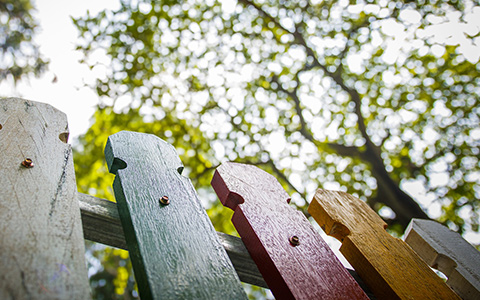
Don’t accept liability for a tree or its overhanging branches without clarifying responsibility. Once you know how to determine responsibility for a tree and its overhanging branches, you can better reach fair solutions with your neighbors during a tree dispute.
72tree.com gathered the following information on determining who owns and is responsible for a tree’s overhanging branches, and what actions to take.
Trees and Your Property Line
Whether you find yourself on the giving or receiving end of an overhanging tree complaint, it is essential to know who owns the tree in question.
When you purchased your property, you were likely required to get a property survey. If many years have elapsed or there is difficulty determining where the property line is, have a new survey conducted with the surveyor physically marking the property line.
All trees growing on your property with their trunks inside your property line are your responsibility.
In the rare case that a tree is growing directly on the property line, ownership and responsibility of that tree are equally shared between you and your neighbor.
Overhanging Tree Branches
As a tree grows upward, it also grows outward. Over time, some of those branches can grow past your property line overhanging your neighbor’s yard or home. The responsibilities of each property owner are typically as follows:
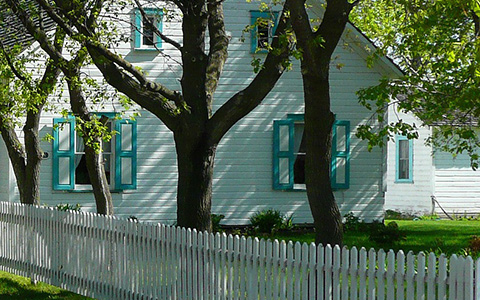
Owner of the Tree – You are responsible for the overall care of the tree, including:
• Watering, mulching, and fertilizing
• Staking or anchoring if the tree becomes unstable or is leaning
• Trimming or pruning the canopy (up to your property line)
• Detecting and treating illnesses and insect infestations. Learn more about tree health problems and solutions at 72tree.com/9-common-tree-health-problems-solutions/
If your tree succumbs to disease, infestation, or dies for any reason, the responsibility to remove the tree is yours. You could be held responsible for the damages it may cause if it should fall.
The Neighbor – Your neighbor is responsible for the following:
• The trimming or pruning of overhanging branches up to their property line*
• Cleaning fallen leaves, needles, twigs and other debris from the overhanging branches
Your neighbor should also make any concerns or complaints about potential hazards from the tree known to you.
If your neighbor documents this communication or files a complaint with the town, and you do nothing, you may be held liable for damages caused by any portion of the tree falling on your neighbor’s property.
*All trimming or pruning activities must be done in a way that promotes the health of the tree. If your neighbor’s actions result in the declining health or death of the tree, they may be held liable for the cost of the replacement of that tree.
Your Tree Falls on Your Neighbor’s Property
If your tree or a portion of the tree should fall on your neighbor’s property, the health of the tree when it fell is vital in determining responsibility.
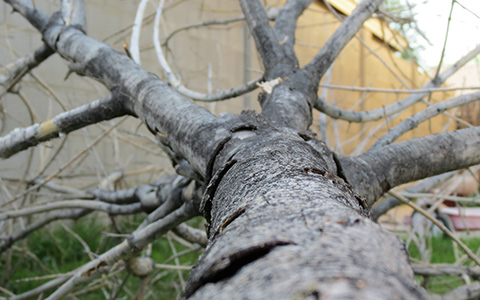
Healthy Tree – If the tree was healthy and well maintained with no signs of decay or infestation, the removal and any damages caused by the tree will be your neighbor’s responsibility.
The majority of homeowners insurance providers will cover such a claim.
Diseased or Dying Tree – If your tree had clear signs of disease, infestation, rot, or your neighbor filed a complaint about the hazard, you could be held liable for all damages caused by the falling tree.
Protect yourself and your neighbors by hiring a trusted tree service to perform annual inspections of your trees. These inspections allow them to detect any potential trouble and recommend a course of action.
Learn more about what to do when a neighbor’s tree falls on your house at 72tree.com/my-neighbors-tree-fell-on-my-house-now-what/
View Obstruction Ordinances
Throughout the United States, there are a few cities with “view ordinances.” These ordinances state the importance of the view to the value of the property.
If your tree reaches a height that obstructs a neighbor’s view (in a city with such ordinances), you may be ordered to reduce the height of the tree or remove it.
Before planting new trees on your property, it is worth the time and effort to research your city’s laws for these specific ordinances. Once you know the limitations imposed by these ordinances, you can select the appropriate species to plant.
Overhanging Tree Responsibility
In this article, you discovered how tree ownership is determined, what you are responsible for when trees overhang a neighbor’s property, and their responsibilities.
By properly caring for your trees and having them inspected annually, you can detect potential issues early and get them resolved before turning into a problem or dispute.
If you choose to neglect the health of your tree(s), you can be held liable for all damages caused by that tree falling on your neighbor’s property or house.
NOTE: Cities, municipalities, and towns have ordinances that may vary from the information presented in this article. It is always recommended that you search for your city’s tree ordinances to fully inform yourself.
Sources:
http://agrisk.umd.edu/blog/frequently-asked-questions-can-i-cut-my-neighbors-tree-back-from-our-property-line
hg.org/legal-articles/neighbor-s-right-to-build-36677
extension.tennessee.edu/publications/Documents/SP687.pdf
secure.caes.uga.edu/extension/publications/files/pdf/C%201099_1.PDF
Notice: Undefined variable: page in /home/vrxdg1855sn3/public_html/wp-content/themes/72tree/content.php on line 15
Notice: Trying to get property 'ID' of non-object in /home/vrxdg1855sn3/public_html/wp-content/themes/72tree/content.php on line 15
A Beginners Guide to Tree Planting
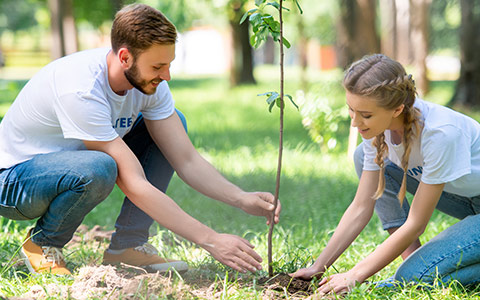
Your tree is more likely to die if you don’t consider the factors that affect its development during their planting. Your trees’ health is directly correlated to the time, location, pre-planning, and species that you choose ever before planting.
72tree.com assembled the following guide with professional tips to help you properly plant and care for your tree.
Best Time to Plant Trees
There is much debate as to when the best tree planting time is. For more moderate climates such as the south, southeast, or southwest, either early fall or early spring are appropriate planting times.
For locations where there is winter snow cover or ground freeze, spring (after the ground thaws) is the best time to plant.
Tree Location
Now that you’ve decided to plant a tree and identified the best time, you’ll need to choose a suitable location. In doing so, take the following factors into consideration:
Sunlight – Does the planting location get full sun (all day), partial sun (morning or evening), or full shade (no sun)
Water – Most tree species require well-drained soil. If your chosen location is in a low-lying area or a depression, water may accumulate and stand, leading to root rot and other diseases.
Tip: Verify that your location is well-drained after a rainstorm or run a hose at the site to see how the water accumulates or runs off.
Soil – The soil where you plant your tree should be loose, mixed with organic material, and turned to avoid compaction.
Tip: Many tree species can thrive in a soil pH level between 5 (acidic) and 7(neutral). You can raise the soil pH by adding lime or limestone and reduce the pH by adding aluminum sulfate, sulfur, manure, or compost (pH levels above 7 are alkaline).
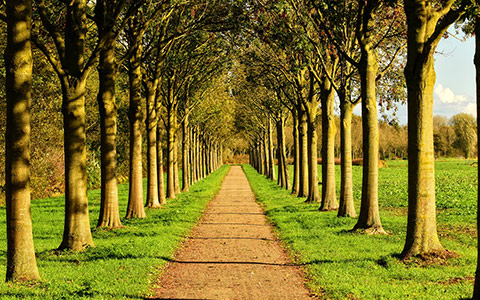
Spacing – When planting multiple trees, they can be spaced apart according to their mature canopy spread. Tree spacings from 20 to 60 feet apart are standard. This spacing allows the open-grown form of the tree canopy to develop naturally.
Conversely, when planted too close together, a tree may fail to reach its mature height and struggle to absorb enough sunlight and nutrients to remain healthy.
Tip: Follow spacing recommendations for your specific tree species.
Wind – The location you’ve selected should be observed over time to determine whether or not your tree will endure constant wind or violent wind gusts.
Tip: Stake young trees until they can support themselves without bending under pressure. Most trees will take one to two years before fully establishing their root systems.
Structures – A tree’s roots spread far from where it is planted. As roots spread, they thicken and may become invasive. When a tree is planted too close to a house, sidewalk, patio, or driveway, those roots can grow underneath the structure and break up or buckle the concrete.
Tip: Plant trees far from structures with concrete foundations or slabs, and install root barriers to protect building foundations, driveways, sidewalks, etc.
Protection – Weather and wildlife can stress or kill your tree as it matures. By planting shrubs near and around your tree, you can naturally lessen the impact of wind. Surrounding structures will also act in this capacity.
Tip: Discourage wildlife from grazing your tree’s foliage or damaging its bark by putting up chicken wire around the tree, using bark wraps, or by using chemical deterrents.
The USDA Plant Hardiness Zone Map defines planting zones from 1a to 13b. The zone in which you plan to plant a tree will determine which species you should select. You can determine your hardiness zone at planthardiness.ars.usda.gov/PHZMWeb/InteractiveMap.aspx
Tree Species
The species of tree you decide to plant can profoundly impact the surrounding landscape in various ways. Verify that the species you intend to plant is appropriate for the location in which you are planting and consider the following:
Deciduous or Evergreen Trees – If you want your tree to maintain a lush green appearance year-round, you are looking for an evergreen species which may include:
• Blue Spruce
• Scots Pine
• Green Giant Arborvitae
• Magnolia
• Holly
• Leyland Cypress
If you want to enjoy fall colors as your tree prepares to go dormant for the winter, you are looking for one of the many deciduous species which may include:
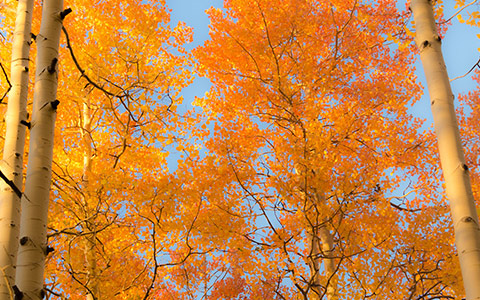
• Oaks
• Maples
• Birch
• Sweetgum
• Tulip
• Quaking Aspen
Tip: Regarding quaking aspens, the species has an invasive root system and will produce suckers that are clones of the original tree. When planting this species, be sure that it has enough space to grow and spread without obstruction.
Understory or Overstory – An understory tree may be best if your planting location is restricted or you desire a mid-sized tree. The following species are considered understory, and are shade tolerant reaching mature heights of 20 to 40 feet:
• Flowering Dogwood
• Eastern Redbud
• White Fringetree
• Japanese Maple
• Black Aldar
If you are looking for a tree that makes a statement by its size and you have the landscape to accommodate its growth, the following overstory species reach mature heights of 60 to over 100 feet:
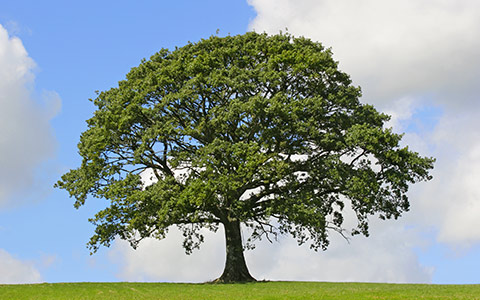
• Southern Magnolia
• Green Ash
• White Oak
• Southern Red Oak
Tip: When planting multiple trees, understory trees can be planted near overstory trees as protection from strong or persistent winds.
For more info, refer to 72tree.com/tree-buying-tips/ before purchasing the trees you intend to plant.
Planting Your Tree
When planting a seedling or sapling, the following should be considered in the preparation of the planting location:
Surrounding Soil – Organic material or pH stabilizing material should be mixed into the soil in no less than a 2-foot radius of where the tree will be planted.
Tip: When transplanting a more developed tree, treat the soil in a 3 to 4-foot radius of the planting location.
Dig the Hole – Measure the distance from the bottom of the trunk to the bottom of the roots or root ball; this is how deep your hole must be. The hole must also be wide enough for the entire root ball to fit without being cramped or bent.
Tip: To confirm the accuracy of the depth, allow the tree to rest in the hole paying particular attention to where the roots connect to the tree. Known as the root flare, it should remain just above the ground.
Water in the Hole – Before planting your tree, provide a deep watering for the hole, allowing water to soak deep into the earth below. This moisture will encourage roots to grow deep.
Plant the Tree – Now that your hole is dug, the soil enriched, and the ground watered, place your tree in the hole covering the roots with soil up to the root flare.
Tip: When covering the roots with soil, do not overly compact it. Water the newly planted tree and allow the soil to settle. As the soil settles, add more to the top, keeping the root flare just above ground level.
Watering – Your newly planted tree should receive a deep watering 2 to 3 times per week. Avoid shallow waterings as they encourage roots to grow to the surface.
Tip: Use a slow-release watering system which maintains constant moisture while allowing proper drainage for excess water.
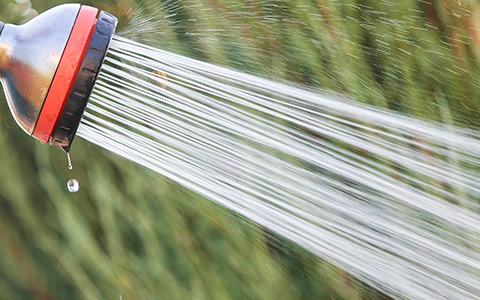
During rainy seasons, scale back the watering schedule and increase it during periods of drought. Don’t allow the soil to dry out for newly planted trees completely.
Fertilizer – If you have prepared the soil in and around the planting location, no fertilizing should be necessary for the first full year of growth.
Tip: Use organic mulch around the tree. As it decays, mulch releases nutrients into the soil. An added advantage is that mulch helps the soil retain moisture and warmth, both of which are fundamental for healthy root growth.
Tree Planting and Your Landscape
Your tree is likely to struggle and die without considering the factors that influence its growth when it is planted.
In this article, you discovered how to determine the correct tree species for your landscape, how to prepare the planting location, and pro tips to help you avoid common mistakes when planting a tree.
Your lack of knowledge about soil, sun, water, location, and species when planting a tree can result in its declining health and eventual death.
Sources:
extension.umn.edu/planting-and-growing-guides/watering-newly-planted-trees-and-shrubs
static.colostate.edu/client-files/csfs/pdfs/TreePlanting_636.pdf
extension.umn.edu/trees-and-shrubs/choosing-evergreens-your-landscape
Notice: Undefined variable: page in /home/vrxdg1855sn3/public_html/wp-content/themes/72tree/content.php on line 15
Notice: Trying to get property 'ID' of non-object in /home/vrxdg1855sn3/public_html/wp-content/themes/72tree/content.php on line 15
How to Fix Exposed Tree Roots
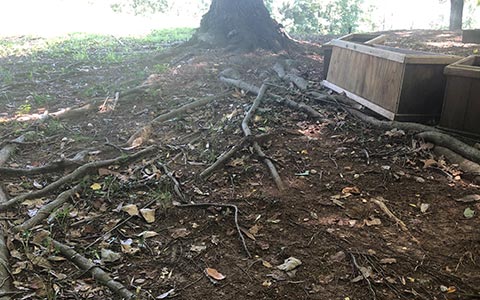
Are ugly surface roots buckling your concrete driveway or stopping you from mowing your lawn? Before you get frustrated and cut them out, there are some things you need to know.
72tree.com gathered the following information on how to handle surface roots without compromising the health of your tree.
Why Do Tree Roots Surface
While some roots grow deep in the ground, the majority of them spread out from the trunk within the first 4 to 12 inches of soil. As the tree ages, several factors may bring them to the surface:
Erosion – Over time, the top layers of soil may be washed away, lowering the ground level, subsequently exposing tree roots.
Soil Compaction – As tree roots spread out, they seek moist aerated soil to derive water and nutrients. When they run into compacted soil, they will turn downward or upward, and in many cases will grow along or just beneath ground level.
Natural Growth – The same way a tree trunk and limbs increase their girth with age, so do roots. Since the majority of tree roots grow within the first few inches of soil, they tend to break the surface as they thicken.
Species – Some trees grow this way. Species such as maples, poplars, and willows tend to grow surface roots.
As annoying as it may be, surface roots are a common landscape problem that can cause significant and costly damage.
Surface Root Problems
When tree roots surface, there are many potential issues they bring with them. Those issues may include:
Disease, Infestation, and Rot – Surface roots are highly susceptible to being injured or damaged by landscaping equipment, foot traffic, or wildlife. Damaged surface roots are easily infected by disease, or infested by insects and can carry harmful pathogens to the trunk and branches of the tree.
Damaged Driveway or Sidewalk – As these roots thicken and surface, the ones that have grown under sidewalks, driveways, and foundations will eventually exert enough pressure to raise or break them.
Read more on how tree roots can buckle a driveway and what to do at 72tree.com/tree-roots-buckling-concrete-driveway/
Damaged Landscape Equipment – Lawnmowers and other mechanical equipment can be severely damaged when making contact with surfaced tree roots.
Abnormal Growth – Where Tree roots surface, any grass or plant life surrounding those roots may become sparse or die.
Trip Hazard – When surface roots are further exposed by erosion, they may become a severe trip hazard when navigating your landscape.
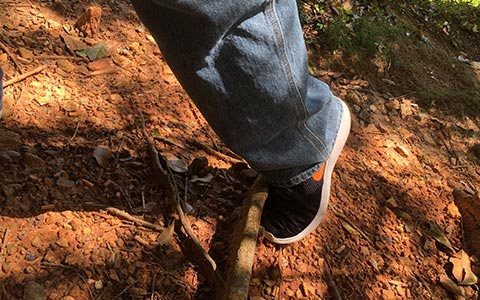
Surface Root Solutions
While cutting the roots away may seem to be the best alternative, it is not. Cutting away roots (like damaging them) leaves the tree highly susceptible to deadly diseases and infestation.
The following are ways to resolve surface root issues without causing severe damage to the tree:
Mulch – At the first sign of roots breaking the surface, lay down a 2 to 3-inch layer of organic mulch. Mulch will help the soil retain moisture, and over time may redirect the roots to grow downward.
Soil Replacement – In cases of erosion exposing roots, lay down a 3 to 4-inch layer of soil to replace what was eroded. To prevent further erosion, you can mulch the area around the tree, seed the new soil with grass, or lay down sod.
Plant Plants – Where erosion is not the problem, one solution may be planting the area with taller ground cover or plants that won’t need mowing. As you create this “tree root garden,” take care to avoid damaging the roots while planting.
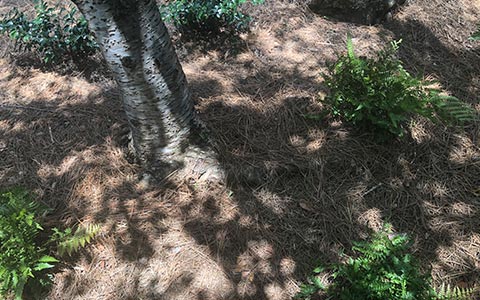
If you are still inclined to have the roots removed, hire an arborist to do this for you. Depending on the damage that may have already occurred, and type of roots that will be removed, it may be suggested to remove the tree.
Surface Root Prevention
Avoid the inconvenience of surface roots by taking action before they come to the surface:
Planting Location – Each tree species has a preferred type of soil, light, and nutrients for healthy growth. By planting trees in optimal conditions for their species, roots will be less likely to surface as the tree ages.
Soil – The soil type, moisture level, nutrient content, and pH level affect how tree roots grow. Deep watering, seasonal fertilizing, and annual pH level adjustments will encourage tree roots to grow deeper.
Species – As mentioned earlier, some tree species are prone to grow surface roots. When selecting trees for your landscape or yard, be sure to ask about the tree’s growth patterns, and do your research on the species needs for optimal growing conditions.
Read more about tree planting and care at 72tree.com/tree-planting-guide/
Exposed Tree Root Solutions
Don’t let gnarly surface roots discourage you from having a beautiful landscape. There are ways to incorporate them in your design without fatally wounding your tree.
In this article, you discovered why tree roots come to the surface, the problems they can cause, and measures you can take to solve and prevent them.
Your mishandling or damaging of surface roots can lead to the health decline and death of your tree. Before you cut roots away, call a professional to evaluate the situation and offer alternatives to save your landscape and your tree.
Sources:
https://extension.umd.edu/hgic/topics/surface-roots
https://www.purdue.edu/hla/sites/yardandgarden/when-tree-roots-surface/
Notice: Undefined variable: page in /home/vrxdg1855sn3/public_html/wp-content/themes/72tree/content.php on line 15
Notice: Trying to get property 'ID' of non-object in /home/vrxdg1855sn3/public_html/wp-content/themes/72tree/content.php on line 15
How is Your Tree Fighting Global Warming
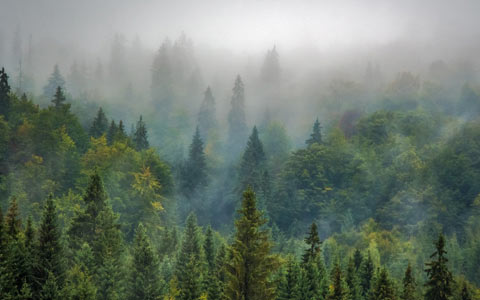
Did you know that your tree is part of a global carbon sequestration system that sustains breathable air for the human race? In fact, without trees, life on earth as we know it would cease to exist.
72tree.com gathered essential information about the role of carbon sinks and how keeping your tree healthy plays a vital role in combating global warming and sustaining breathable air.
What Are Carbon Sinks
A carbon sink is a natural system that absorbs, uses, and stores carbon dioxide from the atmosphere. Technically, you could say that anything that absorbs more carbon than it releases is a carbon sink.
Earth’s principal carbon sinks are:
Trees and Plants – Trees and plants use carbon dioxide captured from the atmosphere for their photosynthesis (food making) process.
Oceans – The oceans play a significant role in storing carbon dioxide. Some marine life will capture the gas for photosynthesis, while some of the gas simply dissolves in the water.
Soil – As plant life dies and decomposes, a portion of its captured carbon dioxide is transferred to the soil.
Nearly a quarter of the carbon dioxide humans have released into the atmosphere has been absorbed by trees and plants. As atmospheric carbon dioxide levels increase, so increases carbon fertilization.
Carbon Fertilization and Tree Growth
As atmospheric carbon dioxide levels increase, more is available to convert to plant matter through photosynthesis, and trees can grow more. This increased growth is referred to as carbon fertilization.
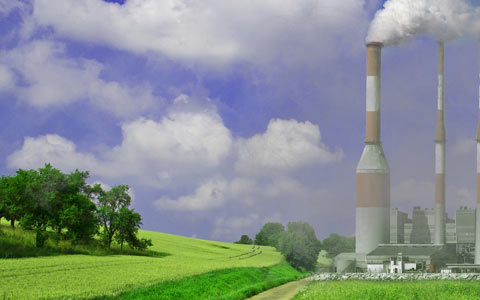
Because of carbon fertilization, trees will continue to grow larger and for more extended periods, as long as their necessity for water, sunlight, and nutrients (primarily nitrogen) is met. If a tree is missing just one of these necessities, it will not grow regardless of the abundance of the others.
Tree Planting and Forest Conservation
Tree planting and forest conservation are vital activities towards the reduction of mankind’s carbon footprint, as trees are remarkably efficient at carbon sequestration, they provide up to 30% of the global action required to stop climate change.
In fact, a single healthy tree is capable of releasing around 6,000 pounds of breathable oxygen over 50 years. That’s about the oxygen consumption of 4 people per year.
With 3.04 trillion trees worldwide and a world population of 7.53 billion, trees alone produce approximately 4,845 pounds of oxygen per person per year. While this number seems reasonably sufficient, carbon emissions are on the rise around the globe, leaving the ominous question of “How long can our trees sustain our oxygen requirements?”
Along with rising carbon emissions, trees and forests, do not always act as carbon sinks. In fact, massive carbon releases by trees may occur at any time when triggered by:
• Deforestation
• Tree and plant decay
• Forest fires
• Wildfires
• Volcanic eruptions
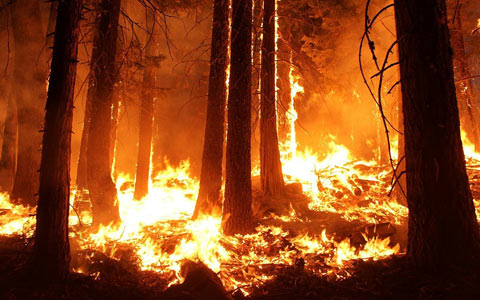
Suffice it to say that as long as carbon emissions continue rising, and the global tree population is threatened, the delicate balance of carbon sequestration and oxygen production can easily slide in the wrong direction.
Tree and forest conservation is one of our best weapons to fight global warming, and it starts in your yard. Keep your trees healthy by making sure they:
• Are planted in the right place
• Have the best soil type for the species
• Have sufficient water
• Are fertilized before their growth period
• Are seasonally pruned
• Are properly mulched
• Inspected annually for disease and infestation
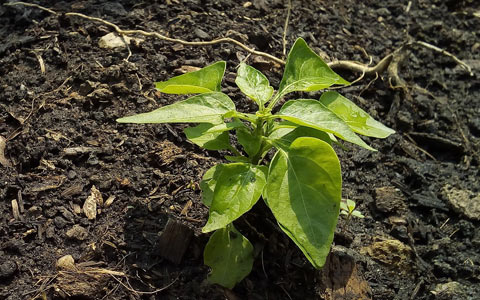
Learn more about planting trees at 72tree.com/tree-planting-guide/
When living near or visiting a forest, you can participate in its conservation by:
• Camping in only designated areas
• Removing or disposing of your trash properly
• Building fires in designated fire-pits
• Fully extinguishing fires before leaving
• Disposing of matches and cigarette butts properly
• Not discharging fireworks
• Reporting suspicious activities
• Notifying park rangers of dead or dying trees
• Avoiding all activities that can physically harm trees
Learn more about forest conservation and preventing wildfires at redcross.org/get-help/how-to-prepare-for-emergencies/types-of-emergencies/wildfire/how-to-prevent-wildfires.html
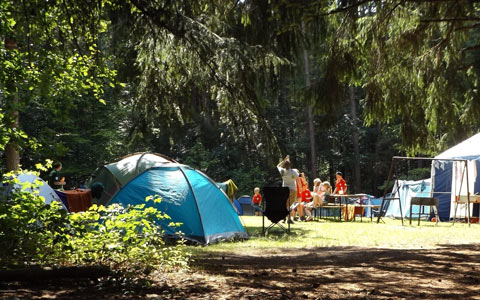
Your Tree, Climate Change, and Global Warming
It may be hard to imagine, but by keeping your trees healthy, you are actively pushing back against climate change and global warming. The human race owes its breathable air to the global population of trees, as they sequester carbon dioxide and release the oxygen we breathe.
In this article, you discovered the function and importance of carbon sinks, how your tree plays a significant role in global oxygen production, and how healthy trees and forests help to stop climate change and reverse global warming.
By keeping your trees healthy, you are actively participating in the reduction of atmospheric carbon dioxide, thus slowing climate change and global warming.
Sources:
https://earthobservatory.nasa.gov/features/CarbonCycle/page5.php
https://www.americanforests.org/blog/forests-carbon-sinks/
https://www.nasa.gov/feature/goddard/2016/carbon-dioxide-fertilization-greening-earth
https://www.conservation.org/stories/Pages/14-forest-conservation-facts-you-need-to-know.aspx
https://www.npr.org/2015/12/26/461095807/tree-counter-is-astonished-by-how-many-trees-there-are
Notice: Undefined variable: page in /home/vrxdg1855sn3/public_html/wp-content/themes/72tree/content.php on line 15
Notice: Trying to get property 'ID' of non-object in /home/vrxdg1855sn3/public_html/wp-content/themes/72tree/content.php on line 15
The Stunning Southern Magnolia Tree and its Flower
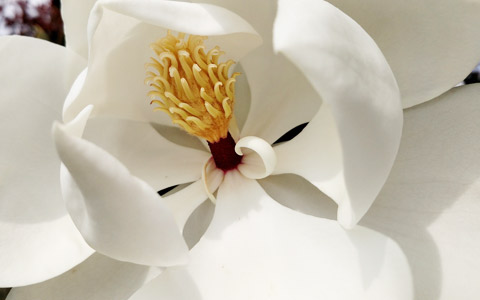
The Southern magnolia (Magnolia grandiflora) is an essential tree for yards and landscapes in hardiness zones 6 through 10, for its size, year-round beauty, and its enormous creamy white flowers.
72tree.com gathered essential information on the Southern magnolia tree, its characteristics, incredible flowers and their blooming season.
Magnolia Tree Information
Magnolia grandiflora, with its full luxurious look, is a favorite specimen around the world. The following are some of its features:
Family – Magnoliaceae
Height – 50 to 80 feet at maturity with some reaching 90 feet.
Width – The base of a fully mature magnolia can reach 40 feet in diameter.
Foliage – Mature leaves are dark glossy green and densely grow up to 8 inches in length by 5 inches wide.
DBH – The diameter at breast height of a fully mature magnolia tree can reach 24 to 36 inches.
Crown Width – This species grows in a pyramidal shape, its mid and lower sections can reach a diameter of 30 to 40 feet and tapers upward to a pointed or rounded crown.
Leaf Drop – While Magnolia grandiflora is an evergreen species, it will drop light foliage throughout the year.
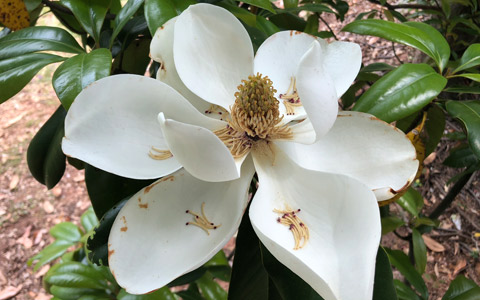
Blooms – The flowers of Magnolia grandiflora are creamy white and can reach up to 12 inches in diameter.
Pests – While magnolia trees are generally free of significant pest problems, some varieties of scale, aphids, mealybugs, spider mites, and leafminers present potential infestations.
Disease – There are several fungi which can cause leaf spots, and in some cases, may lead to heart rot. However, for the most part, fungi are unable to cause any significant damage to adult magnolias. In the event of severe leaf drop or branch dieback, an arborist should be called to evaluate the situation and recommend a course of action.
This magnificent species, native to the southeastern United States, has been planted in cities all over the world. It’s no wonder that Magnolia grandiflora became an instant hit when it was taken to Europe in the 1700s.
Due to its adaptability to many climates and soil types, and its unique beauty, this species has become one of the most widely planted ornamental evergreen trees in the world.
To learn more about the USDA Hardiness Zone Map, read Trees, Shrubs, and the USDA Hardiness Zone Map at 72tree.com/trees-shrubs-usda-hardiness-zone-map/
Magnolia Tree Flower
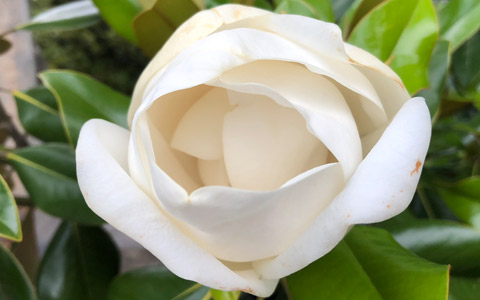
The majestic Southern magnolia tree has an incredibly dominating presence from mid-summer through the end of winter. However, in early to mid spring, this specimen displays its true glory and reason for its worldwide admiration.
When the Southern magnolia blooms, it blooms at the tips of twigs all over with dozens of white lemon citronella-scented flowers open at a time. Healthy mature magnolias bloom consecutively until mid-summer, and these enormous flowers range in size, reaching up to 12 inches in diameter and lasting up to 7 days from bloom to wilt.
The Magnoliaceae family is among the eldest of tree families in existence. Due to this, we get to witness two pre-evolutionary aspects of flowers:
Tepals, not Petals – In magnolia flowers, the petals are fused with the sepals (sepals are typically green and function as protection for the flower while in bud); therefore, the correct terminology for these parts is tepals. The tepals of the magnolia flower are usually arranged in two whorls of 3 to 6 tepals each.
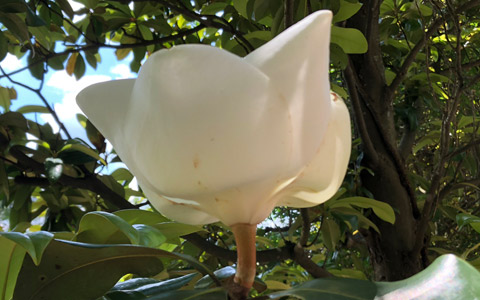
No Nectar Here – That’s correct, magnolia flowers do not produce nectar. These flowers attract pollinating beetles with their fragrant and sugary secretions.
The beautiful magnolia flower is the state flower of Mississippi and Louisiana, while the tree itself is the state tree of Mississippi. It should come as no surprise that the largest Southern magnolia is located in Smith County, Mississippi, measuring more than 122 feet tall with a DBH greater than 6 feet.
The Flowering Magnolia Grandiflora
If you live in the South and your landscape doesn’t include a Southern Magnolia, you’re missing out on one of the oldest and most beautiful blooming evergreen trees in existence.
In this article, you discovered a wealth of information about the Southern magnolia tree and its beautiful flowers.
If your property lies within hardiness zones 6 through 10, and you have yet to plant a magnolia tree, you should consider doing so for the beauty of the tree and the elegance of its sensational flowers.
Sources:
https://plants.ces.ncsu.edu/plants/all/magnolia-grandiflora/
https://hgic.clemson.edu/factsheet/magnolia/
https://www.arborday.org/trees/treeguide/TreeDetail.cfm?ItemID=863
https://edis.ifas.ufl.edu/st371
Notice: Undefined variable: page in /home/vrxdg1855sn3/public_html/wp-content/themes/72tree/content.php on line 15
Notice: Trying to get property 'ID' of non-object in /home/vrxdg1855sn3/public_html/wp-content/themes/72tree/content.php on line 15
Oak Wilt Identification, Treatment, and Prevention
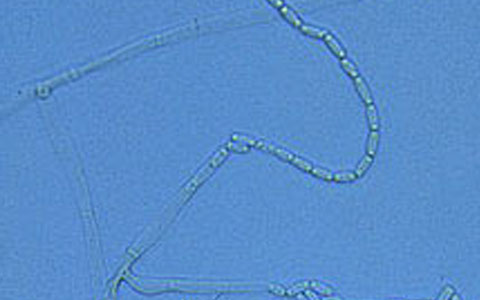
Don’t let oak wilt (Bretziella fagacearum) kill your tree. While few fungi can bring down the mighty oak tree, this is one of them.
Oak wilt is one of the most destructive tree diseases in the United States, and it’s on the loose, killing oak trees at nearly epidemic proportions. If your oak tree(s) appear to be in trouble, its problems may be caused by a fungus that, if not halted, will kill your tree in a matter of months.
72tree.com gathered essential information about oak wilt disease, how to identify it, treat it, and prevent it.
What is Oak Wilt?
Bretziella fagacearum, formerly known as Ceratocytis fagacearum, is the scientific name for oak wilt, and this fungal disease affects all species of the oak (Quercus) genus by disabling the water conducting system in these trees.
Based upon porosity and leaf shape, oaks are divided into two groups; red oaks and white oaks. Bretziella fagacearum affects these two groups differently:
White Oak Group – The species below that are part of this group have rounded leaf edges and pores clogged by tyloses.
• Quercus alba (the most commonly known white oak species)
• Quercus lobata (California white oak or valley oak)
• Quercus polymorpha (Mexican white oak or Monterrey oak)
• Quercus bicolor (swamp white oak)
• Quercus arizonica (Arizona white oak)
• Quercus garryana (Oregon white oak or Garry oak)
Tyloses are outgrowths on cells of xylem vessels. Tyloses fall from the sides of the cells and seal a tree’s vascular tissue to prevent or reduce damage.
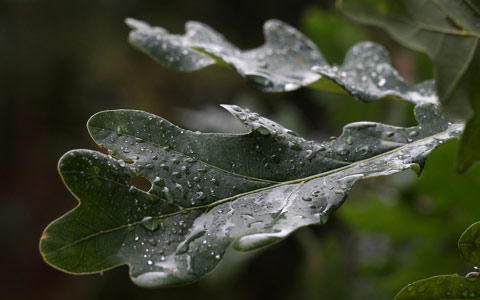
Red Oak Group – The species below that are part of this group have pointed leaf edges and large open pores:
• Quercus falcata (southern red oak)
• Quercus graciliformis (Canby oak or Chisos oak)
• Quercus buckleyi (Texas red oak)
• Quercus rubra (the northern red oak)
• Carnarvonia araliifolia (an Australian rainforest tree)
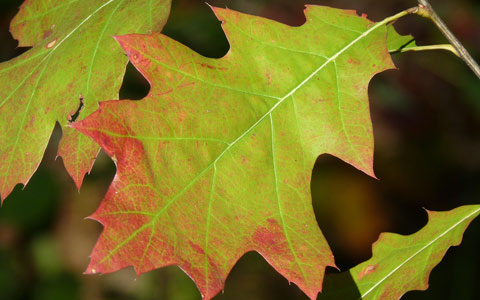
Due to the difference in porosity, species in the red oak group are more easily infected by oak wilt and die more quickly than the white oak group species. In fact, infected trees in the red oak group may die off within a single summer season, where those in the white oak group can persist for several years after being infected.
Another difference is that trees in the red oak group produce fungal spore mats that facilitate the “above ground or overland” spread of the pathogen, whereas the trees in the white oak group rarely produce them.
How to Identify Oak Wilt Disease
Oak trees infected with oak wilt present the following symptoms:
• Leaf chlorosis
• Leaf drop (off-season)
• Dieback from the top down
• Veinal necrosis (Live oak species only)
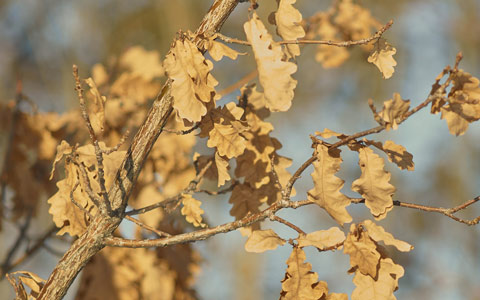
In most cases of infection, oak leaves will turn pale green and then brown while still attached to the tree. By the time they fall, the tree is likely dead.
This disease is dangerous in that it is extremely fast acting; it can kill a mature oak tree in a matter of two to four months while spreading from tree to tree via grafted roots.
Grafted roots occur when the roots of two or more compatible tree species meet and fuse together. Once roots are grafted, they gain the ability to interchange nutrients, water, and disease to each other.
If you suspect that your oak tree is infected with oak wilt, have your tree inspected by an arborist immediately.
How to Treat Oak Wilt Disease
Once Bretziella fagacearum has infected your tree, your fast action is required to halt this pathogen. There are two principle ways to treat oak wilt disease:
Fungicide Treatment – Propiconazole applications are an effective preventative measure. During the earliest stages of infection, this fungicide is injected through holes drilled in the root flare, to the tree’s water-conducting vascular system.
The success of this treatment is greatly influenced by the health of the tree and the fungicide application rate. Any time holes are drilled into a tree for this type of treatment, a professional should be hired to make sure the fungicide is applied correctly and that the holes do not become sources of further infection or infestation.
Trenching to Sever Root Connections – When a tree has been infected and fungicide treatments are no longer viable, trenching will help stop the pathogen from being transmitted from tree to tree by grafted roots.
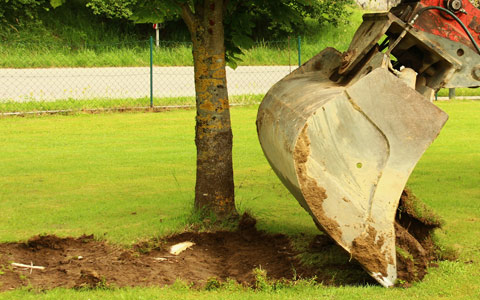
After identifying infected trees, a trench should be dug with a trenching machine, ripper bar, rock saw, or walk-behind trencher to a depth of at least 4 feet (trenches deeper than 4 feet may be required in deeper soil), and a minimum 100 foot radius around the infected tree(s).
Healthy trees within the trench are considered high risk and should be uprooted or removed to improve the effectiveness of the barrier. Tree removal should start immediately after trenching, beginning with the trees closest to the trench, and working inward thereafter until all of the trees within the trench have been eliminated.
An oak wilt contamination can be more easily contained when treatment begins early. Trees outside the trenched area should be monitored for several years after the infected area has been treated, and in the event of further infection, the same procedure (trenching and tree removal) should be repeated while the contaminated area is still manageable.
Oak Wilt Disease Prevention
Tree disease prevention begins with tree health. However, when it comes to oak wilt disease, special care must be taken to avoid infecting otherwise healthy trees. The following will help you avoid spreading the Bretziella fagacearum pathogen to your oaks:
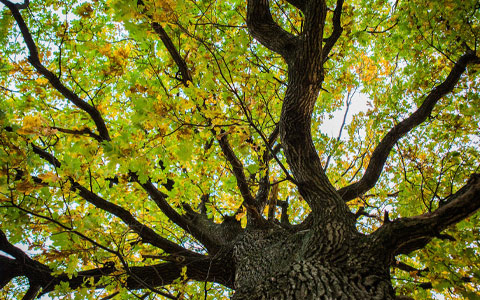
Tree Health – A healthy tree has defense mechanisms that help it stave off attacks from fungi and insect infestation. Whether it be exuding sap to close wounds made by insects, or compartmentalization to contain invading pathogens, the healthier your tree is, the more effective its defense will be. The following steps help you increase your tree’s vitality:
During prolonged dry seasons:
• Provide weekly deep waterings for your trees.
• Fertilize your trees before the growing season begins (February, and early March).
• Mulch your trees to avoid losing soil moisture.
• Inspect your trees frequently for wounds and weather damage (including surface roots), use tree wound dressing, wax based dressing, or latex paint to seal these wounds.
Pruning Activities – Pruning encourages new growth. However, in the case of oak trees, pruning them may provide an opportunity for Bretziella fagacearum to invade and kill your tree. Adhere to the following guidelines when pruning oak trees:
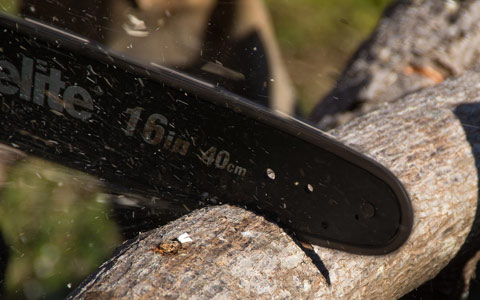
• From February through July, avoid pruning or wounding your oak tree(s). This period is when oak wilt fungal mats are most easily formed, and oak bark beetles (Scolytinae) and sap beetles (nitidulid) are most active.
• Pruning activities should take place during midwinter or extended periods of hot weather in late summer. (these are the periods which present the least threat to your oaks)
• Sterilize all pruning equipment between trees.
• Paint all pruning wounds with a tree wound dressing, wax-based dressing, or latex paint to create an immediate barrier to contaminated beetles or airborne pathogens, regardless of the time of year.
• Freshly cut stumps and wounded surface roots should be dressed immediately, as Bretziella fagacearum can be transmitted from tree to tree through grafted roots.
Diseased Tree Removal – Oak trees that are dead or dying from oak wilt disease should be removed and immediately burned or buried to prevent dissemination of the disease’s spores.
When dealing with infected trees, call on a professional tree service to handle the removal and destruction of these trees. They will also be able to assess the potential risk to surrounding trees and advise you on any further necessary preventative measures.
Firewood Awareness – Avoid purchasing or transporting unseasoned firewood. Since fungal mats may form on unseasoned oak firewood, you could be unintentionally spreading the pathogen to uninfected areas.
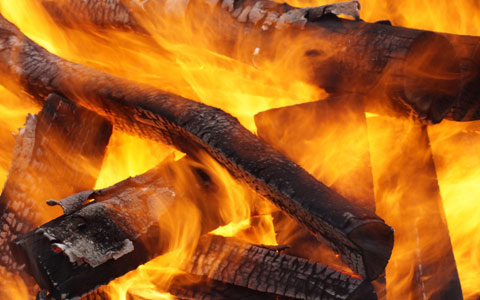
Seasoned firewood has been dried for a minimum of one year and poses little to no threat of spreading the oak wilt pathogen.
Oak Tree Disease – Bretziella Fagacearum
Your mighty oak tree can become infected and die in a matter of months. The Bretziella fagacearum fungus can spread by way of insects, airborne spores, and through grafted roots. By the time you identify the problem, you may be dealing with several infected trees on a fast-track to death.
In this article, you discovered vital information about oak wilt disease, how you can identify it, what you need to do to treat it, and prevention tips.
Your slow response to this fast-acting disease can not only result in the death of your tree, but also to the spread of oak wilt to numerous trees in surrounding environments. At the first sign of trouble, call a professional to help you assess the damage and required measures for containment.
Sources:
https://tfsweb.tamu.edu/OakWiltFAQS/
http://www.inspection.gc.ca/plants/plant-pests-invasive-species/diseases/oak-wilt/fact-sheet/eng/1325629194844/1325632464641
https://www.annualreviews.org/doi/abs/10.1146/annurev.en.07.010162.001551?journalCode=ento
https://www.canr.msu.edu/news/oak_wilt_disease_1
http://www.austintexas.gov/blog/oak-wilt-101
Notice: Undefined variable: page in /home/vrxdg1855sn3/public_html/wp-content/themes/72tree/content.php on line 15
Notice: Trying to get property 'ID' of non-object in /home/vrxdg1855sn3/public_html/wp-content/themes/72tree/content.php on line 15
3 Flowering Trees for Your Alpharetta and Roswell Yard
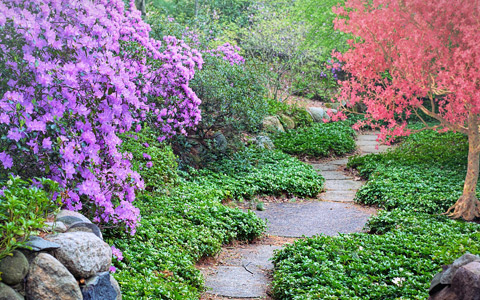
Don’t accept a dull and monochromatic yard. Trees are awakening from their winter slumber and certain species will put on a stunning show of vibrancy and color.
Located in USDA hardiness zone 7b, Alpharetta, Ga is the perfect location for some of the most beautiful flowering trees the South has to offer. If your Alpharetta or Roswell yard doesn’t have one of these trees, you are missing out.
72tree.com gathered care and technical information for flowering dogwood, eastern redbud, and Carolina silverbell blooming tree species perfect for hardiness zone 7b.
Flowering Trees in Alpharetta
The following species are well adapted to the climatic conditions found in Roswell and Alpharetta, Ga. Before choosing a location and breaking ground, read this tree planting guide 72tree.com/tree-planting-guide/
Flowering Dogwood – Cornus Florida is a beautiful tree native to northeastern America, it is hardy in Zones 5 through 9 and flourishes as far west as Texas.
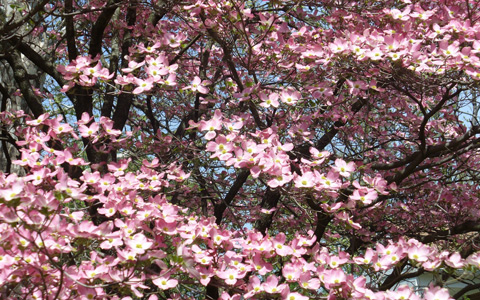
Mature specimens can reach heights of 30 to 35 feet with a crown wider than it is tall. This specimen is considered to be an understory tree with a year-round appeal as it flowers in the spring, maintains attractive foliage throughout summer and fall, and even has an appealing winter appearance.
• Flowering period is April through May with flowers lasting 10 to 15 days.
• Colors include white or pink flowers in spring, bright red fruit in late summer and fall, and light green (spring) dark green (summer) or reddish-purple (fall) foliage.
• Soil should be acidic and well-drained with considerable amounts of organic material.
• Mulch regularly to maintain cool, moist soil.
• Pruning activities should occur either in early or late winter while the tree is in a state of dormancy.
• Susceptible to boring insects, leaf spot, and anthracnose.
When a flowering dogwood must have 25%, or more of its crown pruned to remove an infestation or signs of disease, a certified arborist should be called to evaluate the tree and suggest the best course of action.
Eastern Redbud – Cercis canadensis is noted for being one of the first tree species to flower in the spring. Also native to northeastern America, like the flowering dogwood, it is hardy in Zones 5 through 9 and flourishes as far west as the lower great plains and Texas.
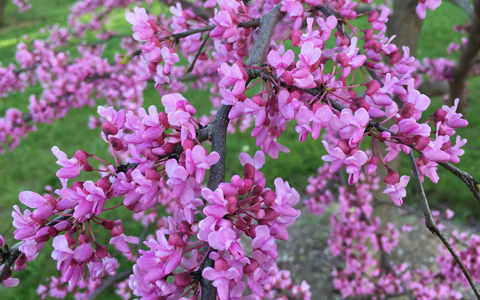
At maturity, the Eastern Redbud reaches heights of 15 to 30 feet with a crown that spreads 25 to 30 feet in diameter. Considered an understory tree, this deciduous specimen provides an incredible show when in bloom.
• Flowering period is March through May before leaf growth. Flowers bloom over the entire crown, creating a “tree of flowers.”
• Colors include pink to reddish-purple flowers, giving way to dark green heart-shaped foliage in late spring.
• Soil should be neutral to slightly alkaline and well-drained for best-growing conditions.
• Pruning activities should occur either in early or late winter while the tree is in a state of dormancy. Pruning helps to strengthen the tree’s structure and promotes its overall health.
• Susceptible to boring insects, redbud leaffolders, grape leaffolder, Japanese weevil, verticillium wilt, Botryosphaeria canker, and leaf anthracnose.
Wildlife tends to leave the Eastern Redbud as a last resort or emergency food source. The tree is fire tolerant, and roots typically sprout after a wildfire or fire-related disturbance.
Carolina Silverbell – Halesia carolina is a flowering understory tree which flourishes in Zones 4 through 8 and is popular for its clusters of white bell-shaped flowers
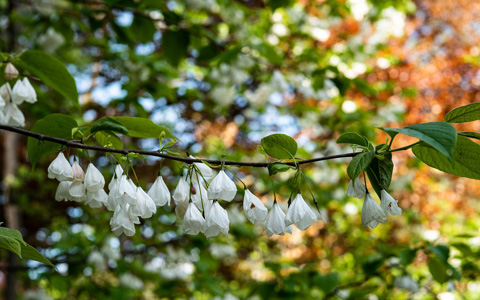
This species reaches a mature height of 30 to 40 feet with its crown reaching up to 35 feet in diameter, and has a rounded or vase-shape.
• Flowering period is April through May with flowers best observed from below as they hang from pendulous stalks in clusters of 2 to 5.
• Colors include white and sometimes rose flowers in spring, green fruit in late summer turning light-brown in fall, and dark green foliage that turns yellow before falling in autumn.
• Soil should be acidic and well-drained with considerable amounts of organic material.
• This species flourishes when grown in light shade and a protected environment.
• Pruning activities should occur either in early or late winter while the tree is in a state of dormancy.
• Susceptible to tree scale when stressed. Healthy Carolina silverbells are otherwise pest-resistant.
Your Carolina silverbell should flourish with minimal seasonal maintenance. However, in the event of drought or changes in the soil pH, the tree may become stressed and appear to droop or wilt. In these cases, call a certified arborist to evaluate the tree, environment, and soil to suggest the best course of action.
After you select some flowering trees for your yard, visit 72tree.com/3-evergreen-species-alpharetta-roswell-yard/ for some perfect evergreens species, 72tree.com/5-popular-alpharetta-ga-shade-trees/ if you need to add some shade to your yard, or 72tree.com/4-shrub-species-alpharetta-georgia-yard/ for the perfect shrubs that can balance your landscape out.
Southern Blooming Trees
As you drive through the streets this spring, you can marvel at some of the most beautiful flowering trees in the South!
In this article, you discovered important information about the beautiful flowering dogwood, eastern redbud, and Carolina silverbell tree species.
Without one of these flowering trees in your yard, you are passing up the opportunity to provide curb appeal and make your yard captivating.
Sources:
https://plants.usda.gov
https://www.wildflower.org/plants/result.php?id_plant=ceca4
http://www.uky.edu/hort/Flowering-Dogwood
http://www.uky.edu/hort/Carolina-Silverbell
Notice: Undefined variable: page in /home/vrxdg1855sn3/public_html/wp-content/themes/72tree/content.php on line 15
Notice: Trying to get property 'ID' of non-object in /home/vrxdg1855sn3/public_html/wp-content/themes/72tree/content.php on line 15
Can We Live Without Trees and How to Save Them

Without trees, we all die. Besides providing oxygen for us to breathe, trees make life on earth sustainable. Discover what is happening to the world’s trees and why we urgently need to stop senseless deforestation.
Trees affect everything from the air we breathe to the rain that falls from the sky. Without a robust population of trees, we die and so does our planet.
72tree.com gathered tree information, statistics, problems, and actions we can all take to preserve our trees and our habitable planet.
What Will Happen if We Cut Down All the Trees?
Right now, just over 3 trillion trees are growing on our planet. Every year, over 15 billion of those trees are felled or lost to natural disasters. At this rate, earth’s last tree will fall in roughly 200 years.
As earth’s tree population nears zero, the following will occur:
Oxygen and CO2 – Trees remove CO2 from the atmosphere and convert it to oxygen through the process of photosynthesis. Without them converting CO2 to oxygen, CO2 levels would begin to rise while oxygen levels would steadily fall.
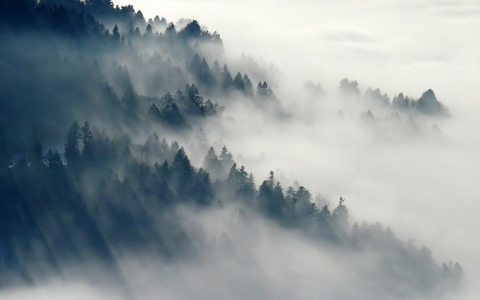
Trees are responsible for 35% of the oxygen we breathe. The other 65% are produced by algae and phytoplankton in the oceans.
Flooding and Erosion – Without tree roots to absorb water and stabilize the soil, even the smallest of storms will result in significant flooding, topsoil erosion, and landslides.
Air and Soil Pollutants – Trees work nonstop to filter ammonia, sulfur dioxide, nitrogen dioxide, and carbon monoxide from the air and soil.
Without trees, these pollutants would find their way into what crops are left and into the feed of what animals are left, not to mention the air we breathe.
Evapotranspiration – Without trees, the process of evapotranspiration would stop. This is the process of moistening the air which produces more clouds. Evapotranspiration is responsible for maintaining the delicate balance between fertile land and dry desolate desert.
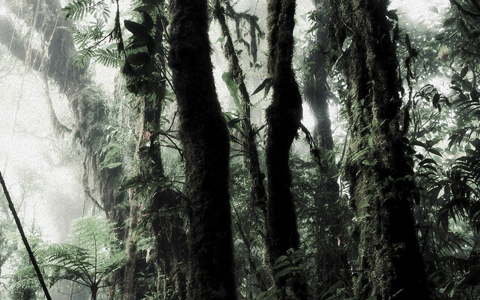
Fewer clouds mean less rain. With less rainfall, fertile land would dry up, fresh water sources would run out or stagnate, and agriculture will begin to fail on a global scale.
Acid Rain – Without trees to remove pollutants, what little rainfall remains would be mostly acidic. All remaining plant life would be crippled.
Global Warming – As the earth’s temperatures rise, the polar ice-caps would melt at an accelerated rate, causing ocean levels to rise and inundate coastal lands and freshwater sources.
As witnessed primarily in the south pole, the ice caps are already receding at an alarming pace, and if this melting isn’t slowed or stopped, it could threaten the survival of all wildlife within that ecosystem.
As the ice melts and causes desalinization in the oceans, weather patterns are subject to erratic change. Off-season snow storms, tsunamis, typhoons, hurricanes, and even blistering summers can all be driven by our raising global thermostat.

Labored Breathing – With CO2 levels on the rise and oxygen levels depleted, people with respiratory and blood problems would be the first to die along with animals unable to cope with the atmospheric changes.
Extinction – Small animals which once depended on trees for food and shelter would be the first to perish. Within a short period, the natural food chain would begin to lose its structure, leaving carnivorous scavengers to likely last the longest.
As temperatures continue to rise, the oxygen levels in the atmosphere decrease, and food sources become even more scarce, the food chain – in its entirety – would eventually break down, leaving every living creature on the planet on a collision coarse with extinction. Including mankind.
The timeline and events portrayed above are a representation of the first fifty to one hundred years without trees.
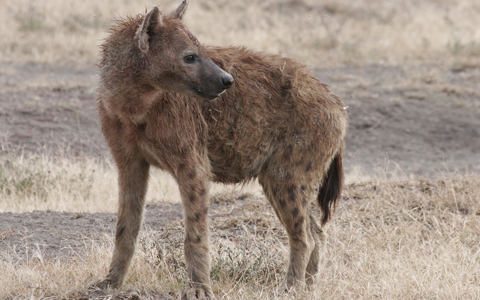
What Can We Do to Stop Deforestation?
You alone can make a tremendous impact on the future of our planet’s tree population. The following are ways that you can help stop deforestation:
Plant a Tree – Every tree you plant slows down the effects of deforestation. However, planting a tree isn’t enough. It is just as important to keep that tree healthy and resistant to disease and insect infestation.
Adding to the complexity of this situation is the process of natural deforestation. This is when beetles and other boring insects successfully attack large numbers of trees in either urban settings or forests. As these trees die, they dry out and become fuel for wildfires.
Besides annual inspections of your trees, whenever you detect the presence of an infestation or disease, call an arborist to assess the situation and offer a course of action.
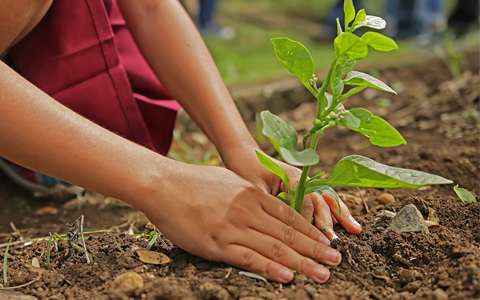
you can discover more about tree health problems and solutions by visiting 72tree.com/9-common-tree-health-problems-solutions/
Go Paperless – Whenever possible, receive and pay bills online. With the technological advances we have at our fingertips, we are able to reduce the use of nearly all paper products drastically.
Recycle – For decades, companies and households of all sizes have been recycling. You can push this concept forward by only purchasing recycled paper products and by recycling yourself.
Look for Forest Stewardship Council Certification – This is known as FSC certification and can be found on wood, paper, and food products. Products with this certification are produced in sustainable ways and can be classified as follows:
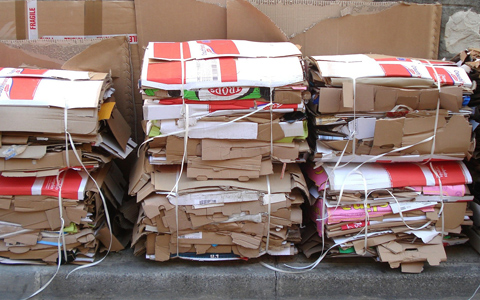
• FSC 100% includes products that come from FSC-certified forests.
• FSC Recycled means the wood or paper within a product is sourced from reclaimed material.
• FSC Mixed means at least 70 percent of the wood in a product comes from FSC-certified or recycled material, and that 30 percent is made of controlled wood.
Eat Vegetarian – By eating vegetarian or vegan meals as often as possible, you are reducing the demand for livestock, thereby reducing the need for deforestation to graze the animals.
Teach Others about Sustainability – The most impactful thing you can do to save our trees and forests is to teach others how to live sustainably.
According to recent research, nearly half of the world’s trees have been lost over the past 12,000 years to agriculture and population growth, and at the rate trees are currently being cut down, they will be gone in 200 years unless we take action to prevent it.
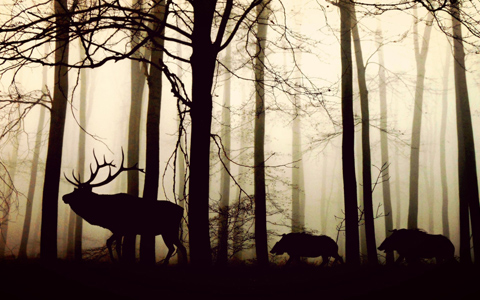
What Can We Do to Save Trees
As mentioned above, planting a tree helps turn back the effects of deforestation, while saving trees is a bit different. To save a tree, you don’t necessarily need to travel to the forest and stand in the way of a bulldozer.
You can save trees every day by caring for the ones that surround you:
• Plant trees in their hardiness zone.
• Plant trees in locations where they can grow freely.
• Adjust soil conditions to match your trees’ needs.
• Prune your trees as it grows.
• Water your trees during dry weather.
• Learn to identify signs of disease and infestation.
• Schedule annual inspections by an arborist.
• When a tree becomes a hazard, have it removed.
That last bullet point may have confused you. There are times when tree diseases or infestations can pose a grave threat to the surrounding ecosystem. In such cases, removing the tree may be the only practical option to protect other trees.
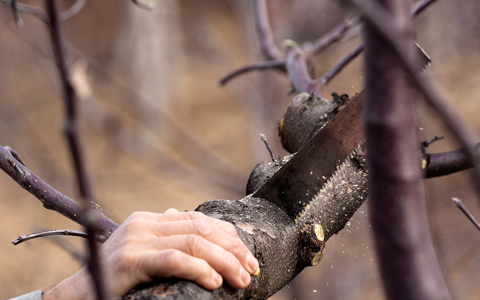
Cutting Down Trees Affects Us and Our Environment
All living creatures including mankind need trees to breathe, eat, and live. Life on earth, at all levels, depends on the abundant existence of a healthy tree population.
In this article, you discovered important tree population information, statistics, problems, and actions we can take to care for our trees and keep our planet habitable.
Ignoring that there is a problem only allows the problem to flourish. If we are to preserve our planet, each of us must take action in some way to keep our trees healthy and rely less on the material possessions that encourage deforestation.
Sources:
https://blogs.worldbank.org/opendata/five-forest-figures-international-day-forests
https://www.epa.gov
https://www.greenpeace.org/usa/forests/solutions-to-deforestation/
https://www.ucsusa.org/global-warming/solutions/stop-deforestation
https://ic.fsc.org/en/what-is-fsc-certification
https://www.nature.com/articles/nature14967
Notice: Undefined variable: page in /home/vrxdg1855sn3/public_html/wp-content/themes/72tree/content.php on line 15
Notice: Trying to get property 'ID' of non-object in /home/vrxdg1855sn3/public_html/wp-content/themes/72tree/content.php on line 15
Tulip Tree Information, Problems, and Care
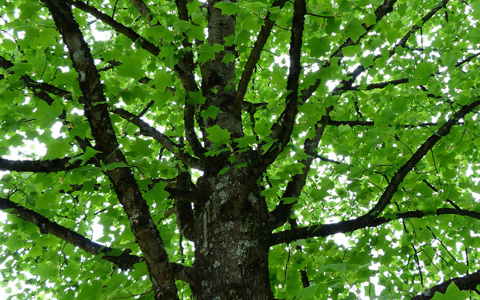
Liriodendron tulipifera also known as tulip poplar is neither tulip nor poplar. This species is a relative of the magnolia tree and is unbelievably easy to care for.
A native North American species, L. tulipifera is the state tree of multiple states, unique in its rapid rate of growth, and exceptional in its beauty. The tulip tree should be strongly considered for mid-sized and large landscapes.
72tree.com gathered tulip tree information, problems, care tips, and answers several frequently asked questions.
Tulip Tree Information
Liriodendron tulipifera is a blooming tree species native to eastern North America. The tulip tree is among the tallest of the eastern US species, is long-lived, and a favorite specimen tree in landscaping.
Tree Name – Yellow poplar
Scientific Name/Species – Liriodendron tulipifera
Family – Magnoliaceae
Genus – Liriodendron
Nickname(s) – Tulip tree, tulipwood, American tulip tree, tulip tree, tulip poplar, whitewood, and Oonseentia (in the native Miami-Illinois language).
State Tree – Indiana, Kentucky, and Tennessee.
Lifespan – Can live up to 500 years or more when planted in optimal conditions.
Type – Deciduous.
Hardiness Zone(s) – from 4 to 9
Soil Requirements – Prefers well-drained, slightly acidic, moist, rich, and fertile soil with full sun exposure.
Planting Spacing – 35ft between trees.
Watering Requirements – Regular when young or planted. Minimal thereafter.
Height – 80 to 100ft on average (can reach nearly 200ft under optimal conditions)
DBH – 4 to 6ft.
Crown Span – 30ft or more at maturity (can be conical or oval in shape).
Root Spread – Yellow poplar roots will tend to match the growth of the tree. If the tree is 100ft tall by 40ft wide, its roots will likely grow 100ft deep and 40ft wide. In some cases, the roots may extend much farther outward in search of water.
Uses in Landscaping – A magnificent specimen, screen, or large shade tree, and is better suited for more spacious landscapes.
Winter/Fall Colors – Yellow before leaf-drop in the fall.
Tulip Tree Problems
Healthy tulip trees are incredibly resistant to insect infestations and disease. However, when your tree is stressed by drought conditions, soil compaction, soil nutrient depletion, or poor pruning, insects and diseases can successfully attack it.
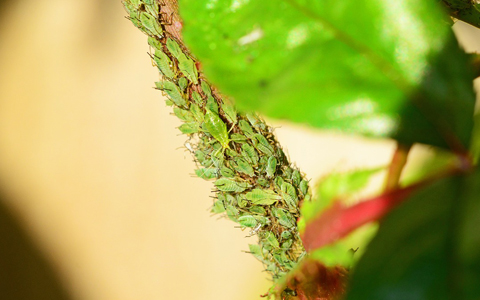
Pests – Tuliptree scale, yellow poplar weevil, and aphids, in the spring and summer months.
Disease – Powdery mildew, verticillium wilt, and canker.
Major Disease Threat – Verticillium Wilt
Symptoms of Verticillium wilt are premature foliar chlorosis and necrosis, and discoloration in both stems and roots. Symptoms of wilting become more apparent on warm or hot days.
This pathogen attacks a potential host by colonizing its roots and spreading throughout the roots, trunks, and stems. Due to this, one of the best forms of disease management is to encourage the healthy growth of your tree.
Tulip Tree Care Tips
There isn’t much you will need to worry about as long as your tulip tree is:
• Within its hardiness zone (4-9).
• Growing in partial shade to full sun.
• Planted in moist, well-drained soil with a pH of 3.7 to 6.5.
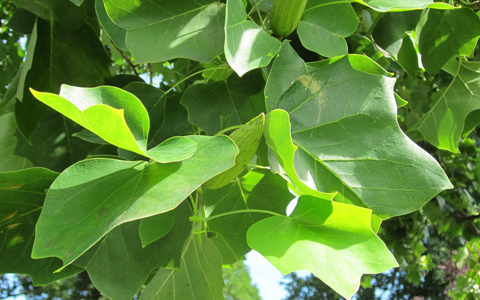
Pruning should be done once the tree has entered dormancy in late fall and early winter. However, when cankers are detected, prune out the affected area including the canker (all the way to the trunk if needed).
If the canker is located on the trunk, or when other irregularities are detected, call on a professional tree service or arborist to evaluate the tree and offer guidance.
People Also Ask
Question: Are tulip tree roots invasive?
Answer: No. If they are planted far from structures, walkways, or driveways, and the roots are readily able to absorb moisture.
Answer: Yes. As with all tree species, the purpose of roots is a never-ending quest for water and nutrients. When they are deprived, they will spread, and make their way underneath foundations and other structures.
For more on the destructive capabilities of tree roots, read 72tree.com/tree-roots-buckling-concrete-driveway/
Question: What is tulip poplar wood used for?
Answer: Lumber from tulip poplars is commonly used for fencing, siding, flooring, and some furniture.
Question: Can poplar wood be painted?
Answer: As this wood has a particularly straight grain, paints adhere to it quite well. Stains, on the other hand, have a tendency to blotch and usually require that a conditioner be applied before application.
Question: Is poplar as strong as oak?
Answer: No. While considered to be a hardwood, the fast growth rate of the tree produces a softer/weaker wood making it easy to work with.
Question: Do tulip trees bloom every year?
Answer: Yes. However, this species only produces its first blooms after nearly 20 years of growth. Thereafter, it will bloom annually in late spring or early summer.
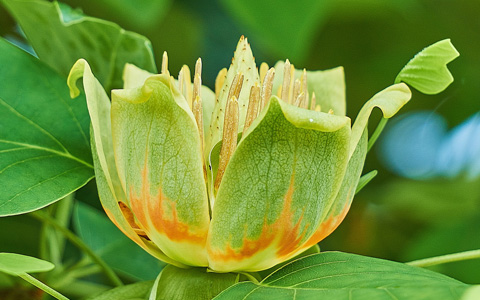
Question: Are tulip trees messy?
Answer: Yes. Like all deciduous tree species, they lose their foliage in the fall. If subjected to drought conditions, tulip trees may drop their foliage prematurely in late summer. Not to mention that when the tree blooms, the flower petals will litter the ground around the tree.
Question: Can tulip trees be planted in Georgia?
Answer: Yes. The entire state is within the required hardiness zone for healthy tulip tree growth. For more on this and other great landscape trees, read 72tree.com/5-popular-alpharetta-ga-shade-trees/
Liriodendron Tulipifera is a Perfect Landscape Specimen
Although sometimes called “tulip” or “poplar,” or both, the Liriodendron tulipifera is neither of the two. This magnificent relative of the magnolia rapidly grows tall and full, making it highly desirable as a landscape specimen tree.
In this article, you discovered tulip tree information and specifications, its problems, how to care for them, and answers to frequently asked questions.
If the tulip tree isn’t a part of your landscape, you are missing out on a fast growing and beautifully shaped shade or screen tree. They are easy to plant and require minimal care efforts.
Sources:
https://extensiongardener.ces.ncsu.edu/extgardener-tulip-poplars-for-large-and-small-landscapes/
http://ipm.ucanr.edu/PMG/GARDEN/PLANTS/tuliptree.html
https://extension.psu.edu/tulip-poplar-diseases
http://www.apsnet.org/edcenter/intropp/lessons/fungi/ascomycetes/pages/verticilliumwilt.aspx
http://hort.ufl.edu/database/documents/pdf/tree_fact_sheets/lirtula.pdf
Notice: Undefined variable: page in /home/vrxdg1855sn3/public_html/wp-content/themes/72tree/content.php on line 15
Notice: Trying to get property 'ID' of non-object in /home/vrxdg1855sn3/public_html/wp-content/themes/72tree/content.php on line 15
Pomegranate Tree Information, Questions and Answers
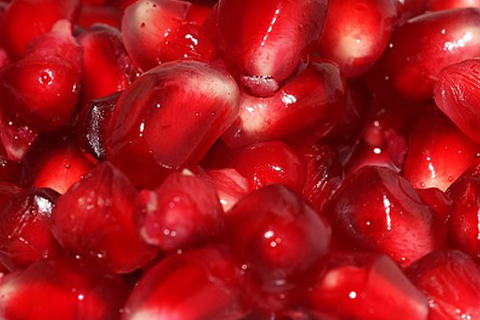
One of the healthiest fruits you can consume comes from the Punica granatum (pomegranate) tree. But how much do you really know about this amazing tree species?
Pomegranate trees produce the incredible pomegranate fruit and have been cultivated for several millennia. Relatively easy to care for, this tree, its flower, and fruit all have profound historical and cultural significance.
www.72tree.com gathered pomegranate tree information and history, care tips, and answers several frequently asked questions.
Pomegranate Tree Information
Pomegranate is a tree species native to the region of Iran to Afghanistan and Pakistan to Northern India. Today, the species is cultivated throughout the Middle East, Northern and Tropical Africa, Asia, the Mediterranean Basin, and parts of the Southwestern United States.
Tree Name – Pomegranate
Scientific Name/Species – Punica granatum
Family – Lythraceae
Genus – Punica
Nickname – Winter Jewels, Red Ruby, and Chinese Apple
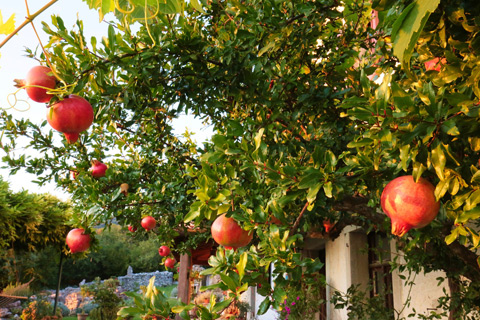
Lifespan – Can live up to 200 years or more when planted in optimal conditions.
Type – Deciduous.
Hardiness Zone(s) – from 8a to 13a
Soil Requirements – Versatile, prefers well-drained rich, fertile soil with full sun exposure.
Planting Spacing – 5 to 6ft
Watering Requirements – Regular when young or planted. Minimal thereafter.
Height – 15ft on average. Can reach 30ft under optimal conditions.
DBH – NA
Crown Span – 8 to 10ft or more at maturity.
Root Spread – Wide and shallow (10-25ft from the trunk and 2 to 3ft deep)
Uses in Landscaping – Highlight tree, border or division, and addition to orchards.
Winter/Fall Colors – Yellow before leaf-drop in the fall.
Pests – Healthy pomegranates are incredibly resilient to insect attacks but may see aphids, whiteflies, mealybugs, and thrips in the spring and summer months. Neem oil or other organic insecticides can be used to control them easily.
Disease – Keeping your pomegranate tree healthy will help it avoid or fight rot, anthracnose, and fungal wilt.
Major Disease Threat – Heart Rot
Pomegranate Origin and History
Originating from Iran to the Himalayas in northern India, Punica granatum (pomegranate) has been grown for several millennia, and was cultivated and naturalized over the extent of the Mediterranean region.
It wasn’t until 1769 that Spanish settlers introduced the first pomegranate specimen to California. Two and a half centuries later, pomegranate trees can be found throughout the US in a commercial capacity as well as in private landscapes and potted in our homes.
Armenian culture sees the pomegranate as a semi-religious icon. A symbol representing abundance, marriage, and fertility, the fruit and its juice are used with Armenian food, heritage, and wine.

As the fruit contains numerous seeds, it is perceived to symbolize fruitfulness. Thus, fostering the tradition to eat the fruit on Rosh Hashana. Besides several mentions in the Bible, some believe the fruit has 613 seeds corresponding to the 613 commandments found in the Torah.
Care Tips for Pomegranate Trees
Pomegranate trees do not require much attention. They are very adaptable to their environment and remarkably resilient to infestation and illness when healthy.
The following tips will assist you in keeping your pomegranate tree(s) healthy and thriving.
Planting Location and Soil – Pomegranates will adapt to nearly any well-drained soil condition regardless of its pH. As long as your specimen receives full sun and is protected from temperatures below 40 degrees Fahrenheit, it should thrive.
Watering – Pomegranate roots grow within the first 2 to 3 feet of soil and do not require deep watering. Keep the soil moist for the first 8 months to 1 year, and again when the tree is bearing fruit.
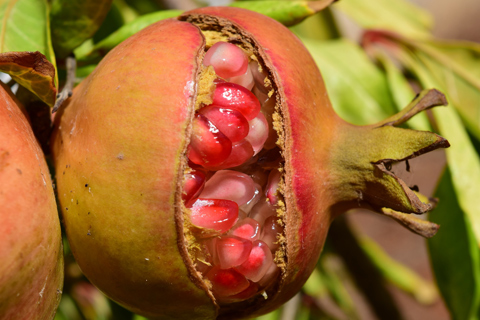
Once the tree’s roots are established, you can cut back to 2 waterings per month in the drier months. By this time though, your tree will be able to tolerate drought conditions.
When the tree is bearing fruit, you can prevent the fruit from splitting by keeping the soil moist.
Fertilizer – After planting a pomegranate tree, you do not need to fertilize it for a full year. The use of organic mulch (manure or compost) will suffice.
Thereafter, each spring, you can apply 2 ounces of nitrogen granules. Increase the dose 1 ounce for each subsequent year.
There are fertilizers specially formulated for fruit trees which may be used as well.
Pruning – Pomegranate trees produce flowers on new growth and can be pruned to remove damaged or dying branches, to shape the tree, or to remove suckers, dead wood, and unwanted growth.
The best time to prune your tree is late winter or early spring before the buds break, and when the threat of frost has subsided.
Be cautious of over-pruning, as it will reduce the amount of fruit your tree is able to produce.
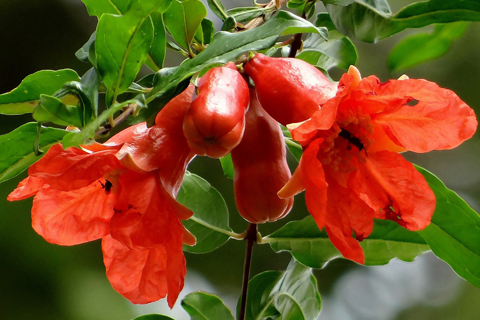
Frequently Asked Questions
Question: Do All Pomegranates Have 613 Seeds?
Answer: No. While some will debate that all pomegranates have this number of seeds, it would be quite easy to prove the contrary.
Question: What Are Pomegranate Seeds Called?
Answer: Arils.
Question: Are Pomegranates Anti-Inflammatory?
Answer: Studies show that pomegranates have excellent anti-inflammatory properties.
Question: What Vitamins Are in Pomegranate Seeds?
Answer: Pomegranates have B vitamins including folate, vitamin C, vitamin K, and potassium.
Question: Are Pomegranates an Antioxidant?
Answer: They have high contents of polyphenols and are renowned for their antioxidant capabilities.
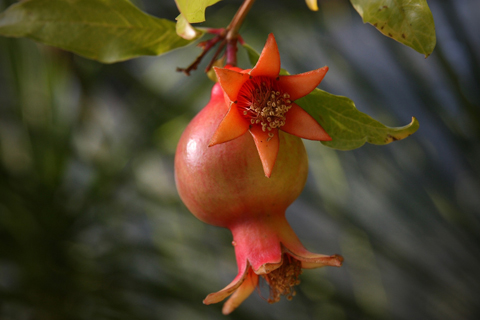
Question: How Long Does It Take for Pomegranate to Fruit?
Answer: Pomegranate trees can take up to 7 months for their fruit to fully mature. The tree itself will only bear fruit after two to three years of hearty growth.
Question: When Do Pomegranate Fruits Ripen?
Answer: Pomegranate fruit in the northern hemisphere typically ripens from September to February, and from March to May in the southern hemisphere.
Pomegranate Trees and Fruit for Your Landscape and Health
Cultivated for thousands of years, the pomegranate tree and its fruit have been gracing landscapes and providing powerful antioxidants through vitamin-rich seeds for generation after generation.
In this article, you discovered the history of the pomegranate tree, how to care for them, and the answers to many common questions about the species.
Growing a pomegranate tree is easy when compared to other fruit trees, and should be a part of your landscape. With a little patience and care, you could have ripening pomegranates in under three years.
Sources:
https://www.science.gov/topicpages/t/total+pomegranate+tannin
https://www.crfg.org/pubs/ff/pomegranate.html
https://hgic.clemson.edu/factsheet/pomegranate/
